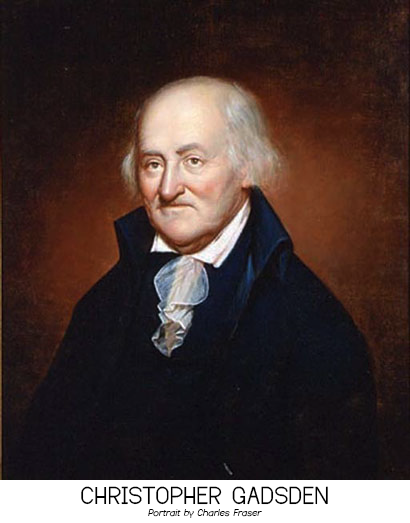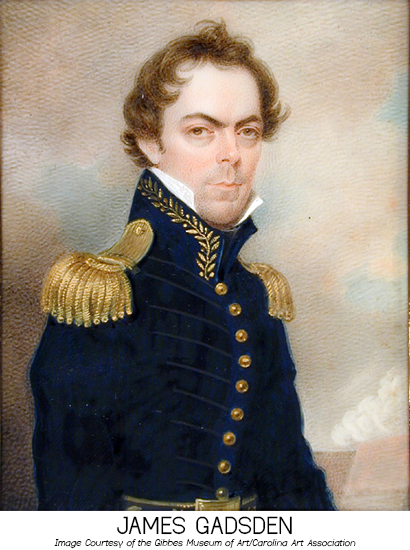Our namesake: Colonel Gadsden
But is that Christopher or James?
- Written by Mike Walsh, Battery Gadsden Cultural Center Board President, February 12, 2019
If you recall visiting the original Battery Gadsden Cultural Center website, you may have noticed a lengthy blog post written by me in 2014. In it I followed up on a comment made by one of our members sometime prior to that in which he briefly identified the namesake of Battery Gadsden as being Colonel Christopher Gadsden, he of the 1st South Carolina Regiment, later Brigadier General in the Continental Army, and well respected Revolutionary War hero.
 I went on to repeat much of what I had found about Gadsden in the book, "Charleston! Charleston!"" written by former Citadel history professor, Dr. Walter J. Fraser.
I went on to repeat much of what I had found about Gadsden in the book, "Charleston! Charleston!"" written by former Citadel history professor, Dr. Walter J. Fraser.
Indeed Gadsden was quite an historical figure. Though perhaps best remembered today for designing what is now known as the Gadsden Flag, the yellow flag with coiled rattlesnake and the words “Don’t Tread on Me”, there are many other reasons to remember Christopher Gadsden. He was a wealthy Charleston native and merchant, an American patriot and agitator against oppressive British rule. Depending on one’s viewpoint he was either a friend or manipulator of the working class. He was both a military and civil leader (He turned down election as governor in 1781 citing his poor health from ill treatment in captivity by the British).
 HOWEVER, he is NOT the namesake of our cultural center and the facility we occupy. What???
HOWEVER, he is NOT the namesake of our cultural center and the facility we occupy. What???
That’s right. Essentially all the fortifications and artillery batteries that have occupied our island over the centuries have been named for someone famous. Take for example Fort Moultrie named for General William Moultrie, or Battery Jasper on the National Park Service grounds named for Sergeant William Jasper who so bravely retrieved the flag during the famous battle on June 28th, 1776.
But the man for whom Battery Gadsden is named may not be so familiar to most people. When the battery was finished in 1904 as part of the “Endicott System” of fortifications it housed four six-inch guns on disappearing carriages, pretty much state-of-the-art stuff at that time. The War Department must have been looking for other famous Carolinians to name it after.
Who they came up with was Colonel James Gadsden, grandson of Christopher. Born in Charleston on May 15th, 1788, he served during the War of 1812 and later under the presidency of Andrew Jackson.
In fact Jackson had him construct a fort on Prospect Bluff in Florida and later named it Fort Gadsden. After the army, James became a railroad executive and later a diplomat. He held some rather outrageous political and social views I won’t go into, but there’s another reason why his name is remembered… the Gadsden Purchase! That was the last addition to the continental U.S. in 1854 when James successfully negotiated the sale of nearly 30,000 square miles of northern most Mexico at a price of $10,000,000. This land ultimately became part of the states of New Mexico and Arizona and today forms part of the border between Mexico and the U.S. James died in 1858 and rests in St. Philip’s cemetery, as does his more famous grandfather.
So if you happen to be down at Battery Gadsden (or in Gadsden, Alabama, Gadsden County, Florida, or Gadsden, Arizona), just remember it’s named for James, not Christopher.
Oral History Collection
The Sullivan’s Island Oral History project’s purpose is to collect and record the experiences and memories of people who have enjoyed a long-term relationship with Sullivan’s Island, South Carolina. The interviews document both facts and lore related to the Island and its culture. By creating digitally accessible oral histories, this project serves to protect these records and to make them available to any and all parties for both personal enjoyment and historical research. Click here to explore the collection stored in the Lowcountry Digital Library.
"The Island Remembered" DVD
One of our thank you gifts for becoming a member!
In 1997 the late Make Macmurphy, founder of what is now Battery Gadsden Cultural Center, conceived the idea of an oral history of Sullivan's Island. With the assistance of Jeri England and Susannah Smith Miles, long time islanders were videotaped reminiscing about island history, culture and daily life. Those many hours of video were edited, assembled and woven together with Miles' script to create The Island Remembered, about a 45-minute production in VHS format. In many an island home today can still be found a copy of that tape tucked away on a shelf, even though the owner may no longer have a VHS machine on which to play it. The video is now available on DVD!
After Macmurphy's death and the resultant dormancy of the Cultural Center, the idea of recording oral histories on Sullivan's Island went no further for many years. However, with the rebirth of Battery Gadsden Cultural Center (BGCC) in 2014 the idea soon resurfaced. But the field of oral history had moved on. There were national organizations, standards and “best practices” in oral history. Extensive textbooks had been written on “how to do” oral history.
Taking all this into consideration a decision was made to give oral history another try with all the up to date standards. Most oral history collections to be found are done as purely audio projects, but based partially on the popularity of Make's original videotape, BGCC decided to try their project in video format. Not only would that allow the viewer the obvious advantage of seeing the speaker, but it would also allow the inclusion of photos and other mementos that could be edited into the file.
The filming is just the first step though. The interview then must be transcribed, edited, abstracted and time indexed so that future authors, researchers and others interested in island history can more easily find various topics. Then comes the ultimate question – where will all this be stored so it can be accessed? The main downside of video projects is the file size. It takes a lot of memory to store video versus audio.
Fortunately at this point BGCC was introduced to the Low Country Digital Library, housed in the Addlestone Library on the College of Charleston campus. This was already home to many oral history collections, though none of them in video format. Working with Tyler Mobley and Leah Worthington at the digital library, BGCC found an excellent partner willing to take on their first video collection.
Seven interviews were videoed and processed. Then on December 14th, 2018, the good news arrived. The Sullivan's Island Oral History Collection was live! Anyone could now enjoy seeing and hearing the memories of individuals with long ties to the island on their computer. Since then an eighth interview has been added, a ninth is being edited and many more are anticipated.
So far the collection includes conversations with people such as Roy Williams, Father Lawrence McInerny, and Bryan Rowell.
Most importantly, if you or someone you know has “a story to tell” about their or their family's connection to Sullivan's Island, please put them in touch with Battery Gadsden Cultural Center at: batterygadsden@gmail.com
Written by Mike Walsh, Battery Gadsden Cultural Center Board President
